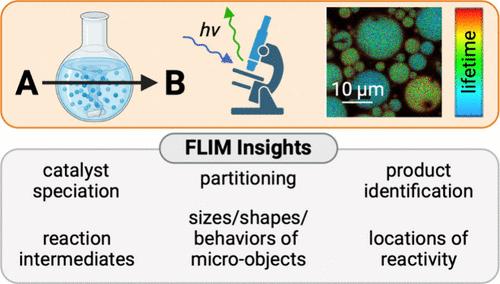Fluorescence Lifetime Imaging Microscopy (FLIM) as a Tool to Understand Chemical Reactions and Catalysis
IF 11.3
1区 化学
Q1 CHEMISTRY, PHYSICAL
引用次数: 0
Abstract
Fluorescence lifetime imaging microscopy (FLIM) is an emerging tool to characterize ongoing chemical reactions in synthetic chemistry and catalysis. Initially applied to biological systems, FLIM now reveals spatially resolved chemical reaction species and system-wide physiochemical changes that accompany ongoing reactions. FLIM combines the advantage of environmental sensitivity with high signal sensitivity (as sensitive as single molecules) and has the key ability to operate under synthetic conditions (e.g., high concentrations of reagents, in organic solvents, under ambient temperature and pressure, in opaque mixtures, and in multiphasic systems). Chemical reactions inherently induce changes in the reaction medium, neighboring compounds, surface compositions, and/or bonding structure of the compounds involved, resulting in environmental changes. The FLIM methods recently developed harness and interpret these changes in ways that lead to characterizing compounds and enhancing a mechanistic understanding. Here, current advantages and limitations of FLIM methods are considered, common factors influencing fluorescence lifetime in chemical systems are discussed in a tutorial format, and seven research case studies are strategically analyzed, chosen to highlight how FLIM provided complementary information to understand chemical reaction mechanisms, intermediates, product distributions, partitioning, roles of reagents, and catalyst behaviors. These data and insights obtained from FLIM assist in the rational design and optimization of synthetic and catalytic methods.

荧光寿命成像显微镜 (FLIM) 作为了解化学反应和催化作用的工具
荧光寿命成像显微镜(FLIM)是表征合成化学和催化中正在进行的化学反应的一种新兴工具。荧光寿命成像显微镜最初应用于生物系统,现在可揭示空间分辨的化学反应物种以及伴随正在进行的反应而发生的全系统生理化学变化。FLIM 结合了环境灵敏度和高信号灵敏度(与单分子一样灵敏)的优势,并且具有在合成条件下(如高浓度试剂、有机溶剂、环境温度和压力、不透明混合物以及多相系统)运行的关键能力。化学反应本身会引起反应介质、邻近化合物、表面成分和/或相关化合物的键合结构发生变化,从而导致环境变化。最近开发的 FLIM 方法可以利用和解释这些变化,从而确定化合物的特征并加深对机理的理解。在此,我们将探讨 FLIM 方法目前的优势和局限性,以教程的形式讨论影响化学体系中荧光寿命的常见因素,并战略性地分析七个研究案例,选择这些案例是为了突出说明 FLIM 如何为了解化学反应机理、中间产物、产物分布、分配、试剂作用和催化剂行为提供补充信息。从 FLIM 中获得的这些数据和见解有助于合理设计和优化合成与催化方法。
本文章由计算机程序翻译,如有差异,请以英文原文为准。
求助全文
约1分钟内获得全文
求助全文
来源期刊

ACS Catalysis
CHEMISTRY, PHYSICAL-
CiteScore
20.80
自引率
6.20%
发文量
1253
审稿时长
1.5 months
期刊介绍:
ACS Catalysis is an esteemed journal that publishes original research in the fields of heterogeneous catalysis, molecular catalysis, and biocatalysis. It offers broad coverage across diverse areas such as life sciences, organometallics and synthesis, photochemistry and electrochemistry, drug discovery and synthesis, materials science, environmental protection, polymer discovery and synthesis, and energy and fuels.
The scope of the journal is to showcase innovative work in various aspects of catalysis. This includes new reactions and novel synthetic approaches utilizing known catalysts, the discovery or modification of new catalysts, elucidation of catalytic mechanisms through cutting-edge investigations, practical enhancements of existing processes, as well as conceptual advances in the field. Contributions to ACS Catalysis can encompass both experimental and theoretical research focused on catalytic molecules, macromolecules, and materials that exhibit catalytic turnover.
 求助内容:
求助内容: 应助结果提醒方式:
应助结果提醒方式:


